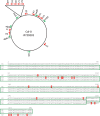Plant mitochondrial genome evolution can be explained by DNA repair mechanisms
- PMID: 23645599
- PMCID: PMC3698917
- DOI: 10.1093/gbe/evt069
Plant mitochondrial genome evolution can be explained by DNA repair mechanisms
Abstract
Plant mitochondrial genomes are notorious for their large and variable size, nonconserved open reading frames of unknown function, and high rates of rearrangement. Paradoxically, the mutation rates are very low. However, mutation rates can only be measured in sequences that can be aligned--a very small part of plant mitochondrial genomes. Comparison of the complete mitochondrial genome sequences of two ecotypes of Arabidopsis thaliana allows the alignment of noncoding as well as coding DNA and estimation of the mutation rates in both. A recent chimeric duplication is also analyzed. A hypothesis is proposed that the mechanisms of plant mitochondrial DNA repair account for these features and includes different mechanisms in transcribed and nontranscribed regions. Within genes, a bias toward gene conversion would keep measured mutation rates low, whereas in noncoding regions, break-induced replication (BIR) explains the expansion and rearrangements. Both processes are types of double-strand break repair, but enhanced second-strand capture in transcribed regions versus BIR in nontranscribed regions can explain the two seemingly contradictory features of plant mitochondrial genome evolution--the low mutation rates in genes and the striking expansions of noncoding sequences.
Keywords: Arabidopsis; DNA repair; mitochondrial genome; mutation rate.
Figures


Similar articles
-
Double-strand break repair processes drive evolution of the mitochondrial genome in Arabidopsis.BMC Biol. 2011 Sep 27;9:64. doi: 10.1186/1741-7007-9-64. BMC Biol. 2011. PMID: 21951689 Free PMC article.
-
Genes and junk in plant mitochondria-repair mechanisms and selection.Genome Biol Evol. 2014 Jun 5;6(6):1448-53. doi: 10.1093/gbe/evu115. Genome Biol Evol. 2014. PMID: 24904012 Free PMC article.
-
RecA-dependent DNA repair results in increased heteroplasmy of the Arabidopsis mitochondrial genome.Plant Physiol. 2012 May;159(1):211-26. doi: 10.1104/pp.112.194720. Epub 2012 Mar 13. Plant Physiol. 2012. PMID: 22415515 Free PMC article.
-
DNA Repair and the Stability of the Plant Mitochondrial Genome.Int J Mol Sci. 2020 Jan 3;21(1):328. doi: 10.3390/ijms21010328. Int J Mol Sci. 2020. PMID: 31947741 Free PMC article. Review.
-
Plant mitochondrial DNA.Front Biosci (Landmark Ed). 2017 Jan 1;22(6):1023-1032. doi: 10.2741/4531. Front Biosci (Landmark Ed). 2017. PMID: 27814661 Review.
Cited by
-
Assembly of the Complete Mitochondrial Genome of Gelsemium elegans Revealed the Existence of Homologous Conformations Generated by a Repeat Mediated Recombination.Int J Mol Sci. 2022 Dec 28;24(1):527. doi: 10.3390/ijms24010527. Int J Mol Sci. 2022. PMID: 36613970 Free PMC article.
-
De novo Assembly and Comparative Analyses of Mitochondrial Genomes in Piperales.Genome Biol Evol. 2023 Mar 3;15(3):evad041. doi: 10.1093/gbe/evad041. Genome Biol Evol. 2023. PMID: 36896589 Free PMC article.
-
Arabidopsis thaliana PrimPol is a primase and lesion bypass DNA polymerase with the biochemical characteristics to cope with DNA damage in the nucleus, mitochondria, and chloroplast.Sci Rep. 2021 Oct 18;11(1):20582. doi: 10.1038/s41598-021-00151-7. Sci Rep. 2021. PMID: 34663822 Free PMC article.
-
Comparative Mitogenome Analysis of the Genus Trifolium Reveals Independent Gene Fission of ccmFn and Intracellular Gene Transfers in Fabaceae.Int J Mol Sci. 2020 Mar 13;21(6):1959. doi: 10.3390/ijms21061959. Int J Mol Sci. 2020. PMID: 32183014 Free PMC article.
-
Evolution and maintenance of mtDNA gene content across eukaryotes.Biochem J. 2024 Aug 7;481(15):1015-1042. doi: 10.1042/BCJ20230415. Biochem J. 2024. PMID: 39101615 Free PMC article. Review.
References
-
- Brenner S. Refuge of spandrels. Curr Biol. 1998;8:R669. - PubMed
Publication types
MeSH terms
Substances
LinkOut - more resources
Full Text Sources
Other Literature Sources

